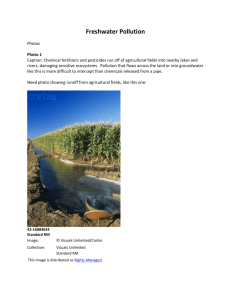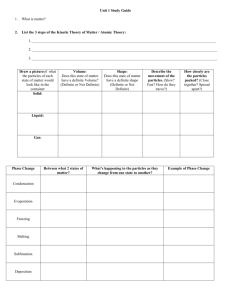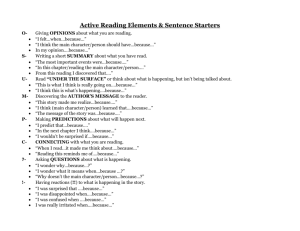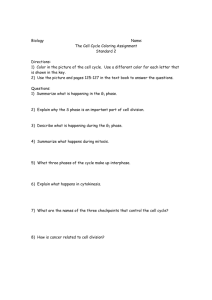Chemistry Unit
advertisement
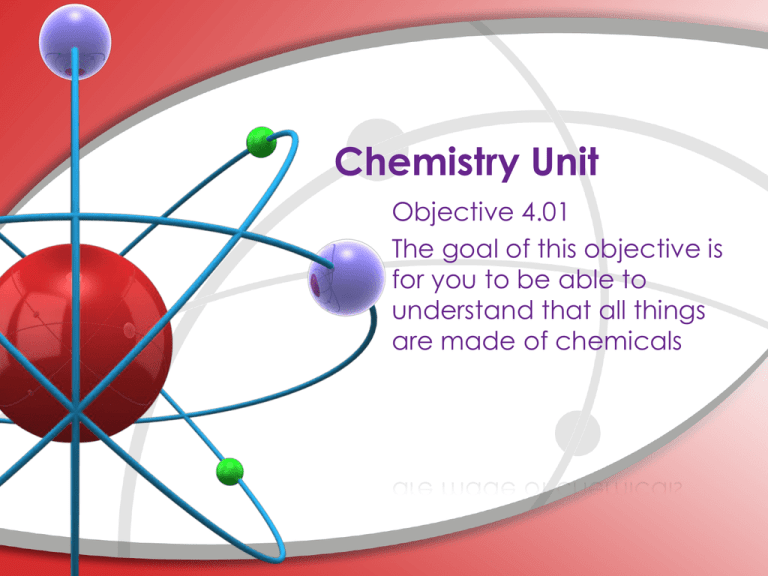
Chemistry Unit Objective 4.01 The goal of this objective is for you to be able to understand that all things are made of chemicals •What is a Chemical? • Fold your notecard in half and draw and color a picture of something that is a chemical • On the back of the notecard define chemical • Are any of the items on the table chemicals? •What is a Chemical? Made of Chemicals • Why are these made of chemicals Not Made of Chemicals • Why are these not chemicals •Natural or Synthetic? Natural Chemical Synthetic Chemical •Health risk? Toxic • Bad for humans and the environment? Nontoxic • Good for humans and the environment? Definition of a chemical A substance made of elements combined into molecules •Chemical •A substance used in or formed by chemical process, • also be defined as any substance with a definite composition—always made of the same substance • Ex. water is always H2O http://www.glogster.com/glog.php?glo g_id=4071521&scale=54&isprofile=true http://alevelnotes.com/?id=135 table salt is always NaCl •Elements combined into molecules water? • table salt? • sugar (glucose)? • caffeine? • 2 hydrogen, 1 oxygen • 1 sodium, 1 chlorine • 6 carbon, 12 hydrogen, 6 oxygen • 8 carbon, 10 hydrogen, 4 nitrogen, 2 oxygen • •Natural vs. Synthetic Natural examples • Natural—CO2, H2O, gold, and sugar Unnatural examples • Unnatural—chemicals made in the laboratory • • • Synthetic chemicals—a chemical not formed in nature, but made by man Found in cleaning products, cosmetics, etc plastics, steel, bronze http://www.random-sciencetools.com/chemistry/chemical_comp_ http://www.chem.ufl.edu/~itl/2045/lect of_body.htm ures/lec_1.html#ans1_2 •Look around you • What objects are made of chemicals? •Synthetic Chemicals • What are some synthetic chemicals that you come in contact with daily • Cleaning products, pesticides, paint, glue, cosmetics, smoke, industrial gases, automobile exhaust, etc •Synthetic Chemicals Daily we come in contact with synthetic chemicals • Some we have control of some we don’t • Complete the chart for your contact with synthetic chemicals • Write down 2 at school, 1-2 on the way home, 2-3 at home, 12 on the way back to school • Synthetic Chemical Exposure Chart What chemical At what were you location were exposed to? you exposed? What was the method of exposure? How much control would you say you had over the exposure? 1= a lot 2= some 3= none •Ticket Out • Create a Venn Diagram—Compare and Contrast a Natural Chemical and a Synthetic Chemical Chemistry Unit Objective 4.01 cont. The goal of this objective is for you to be able to understand that all things are made of chemicals….natural and synthetic •What is matter? Bobby asks, “What is matter?” His older brother replies, “It’s basically anything that takes up space.” “Anything that takes up space?” Bobby inquires. “Pretty much” retorts the brother. “Well big brother, my thoughts take up space in my brain. So, are they matter?”, questions Bobby. Write a brief explanation on how his brother would respond to Bobby’s final question. •Matter • Define • matter Matter is anything that has mass and volume • Mass is the amount of matter in a substance • Volume is the amount of space the substance occupies •Mass and Volume • Quick review • • • Mass is measured in what units? Volume is measured in what units? If you have mass and you divide it by the volume what do you have? • grams • liters • density What do you think will happen to the particle motion as it changes from a liquid to a gas? Observations • During Heating In the Jug 20 minutes After 20 minutes What is happening to the water? What is happening to the milk container? What is happening to the milk carton? What is heat? Why is this happening? Why is this happening? Why does it matter that the water is heated? What is making the container do this? What is the difference of the water now versus the initial pour? As, the water heats what is happening to the particles? How could we test this What change is idea? happening to the water What is happening between the particles? •States (phases) of Matter • Solid—has a definite shape and volume • Liquid—doesn’t have a definite shape, has a definite volume • Gas—doesn’t have a definite shape, doesn’t have a definite volume •States of Matter • Caused by a change in temperature or pressure…by adding or taking away energy • If starting as a solid increasing temperature or pressure changes it to a liquid, and so on and so forth http://www.chem4kids.com/files/matte r_states.html •Compare and Contrast Solid Definite shape Liquid Definite volume Indefinite shape Gas Indefinite shape •Compare and Contrast Molecules compact and close Solid Definite volume Liquid Fill bottom of container Definite shape crystals Chemical Particles Moving Molecules Atoms Particles are free to move Indefinite shape Indefinite volume Gas Fill entire container •Challenge Questions • The temperature at which a solid becomes a liquid is its____________ • The temperature at which a liquid becomes a gas is its______________ •What about BEC? Bose-Einstein condensate • • • • The Scientists Invented in 1995 by Weiman, Cornell, Ketterle Thought of by two scientists in 1920…Albert Einstein and Satyendra Bose Blobs of atoms that are super unexcited and super cold a few billionths of a degree above absolute zero This is the state before a solid http://www.newworldencyclopedia.org/ •The State After Gas Plasma • It’s super excited and super hot • Electrons and ions are free from the element that has been transformed • Depending on the element determines the color of the glow • • http://bogard.110mb.com/Plasmaglobecolors.htm Found in stars, Northern lights, and some light bulbs (florescent) • Plasma in stars is super hot • Plasma in light bulbs is much cooler • http://www.bbc.co.uk/schools/ks2bites ize/science/materials/changing_states /play.shtml What do you think will happen to the particle motion as it changes from a liquid to a gas? Observations • During Heating In the Jug 20 minutes After 20 minutes What is happening to the water? What is happening to the milk container? What is happening to the milk carton? What is heat? Why is this happening? Why is this happening? Why does it matter that the water is heated? What is making the container do this? What is the difference of the water now versus the initial pour? As, the water heats what is happening to the particles? How could we test this What change is idea? happening to the water What is happening between the particles? •Homework • Complete the chart for each material Melting Point Propane Heptane Chloromethane Benzene Phenol Neon Boiling Point Density Phase •Homeworkb • • If you don’t have access to the internet Write a diamante poem which talks about two of the states of matter • For example it could be about solid and liquid, liquid and gas, or gas and liquid • • • • Noun (a) Adjective(a), adjective(a) Verb+ing(a), Verb+ing(a), Verb+ing(a) Noun(relating to a), noun(a), noun(relating to b), noun(b) • Verb+ing(b), Verb+ing(b), Verb+ing(b) • Adjective(b), Adjective(b) • Noun(b) Chemistry Unit Objective 4.01 cont. The goal of this objective is for you to be able to understand that all things are made of chemicals….natural and synthetic •Element • most basic kind of matter, it can not be broken down into simpler substances by ordinary chemical means •Complete the following • What is the difference between a mixture and a compound? List examples for each. •Periodic Table • Elements organized by their atomic number • ~109 elements Amount changes due to them being synthesized in labs • —93 are natural elements, synthetic elements—16 that scientists created • •Mixture vs. Compound mixture • • • Two or more substances combine but don’t join chemically Individual substances keep their properties Ex. Cereal, trail mix, air, etc. •Mixture vs. Compound compound • • • • • Two or more elements combine chemically Individual substances don’t keep their properties Can’t be physically separated Have to be chemically separated (chemical reaction) Ex. Water, salt, etc. http://www.bbc.co.uk/schools/ks3bitesize/science/chemic al_material_behaviour/compounds_mixtures/activity.shtml •Ways to separate mixtures • • • • • Filtration Evaporation Distillation Fractional distillation Chromatography •Ticket Out • • • • • • • • How would you separate the following alcohol and iron filling water and sand water and sugar vegetable soup water and salt rubbing alcohol and water Salt, pepper, water http://www.sciencebuddies.org/scienc e-fairprojects/project_ideas/FoodSci_p006.s html •CANDY OR MARKER CHROMATOGRAPHY ACTIVITY http://www.sciencebuddies.org/mento ring/project_ideas/Chem_p008.shtml
